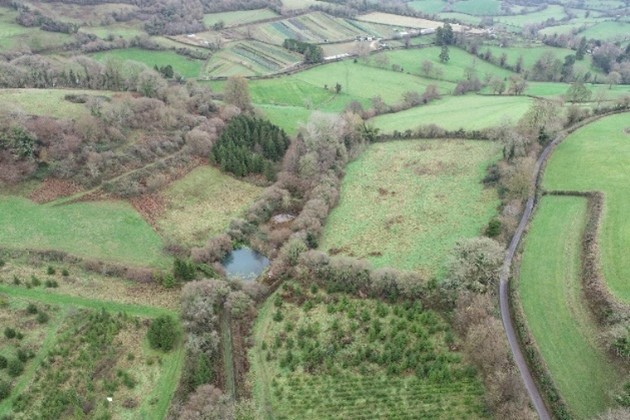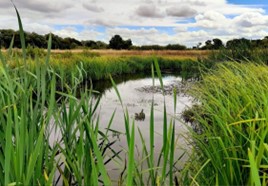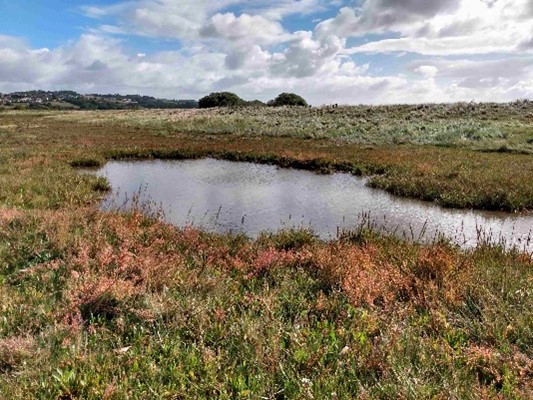Feature Stories
Nature-based Solutions and Conserving Biodiversity
Environment 31 October 2023

Wessex Water is utilising nature-based solutions to tackle environmental challenges at strategically selected sites. Nature-based solutions are sustainable actions that utilise nature to address socio- environmental challenges and benefit both people and the environment.
In addition, as part of the Water Industry National Environment Programme (WINEP), Wessex Water has a five-year project delivered by their Conservation Access and Recreation (CAR) team to support and enhance biodiversity on land at Charmy Down, Durleigh Reservoir, and Bleadon Levels. The project is restoring and creating priority habitats on these sites, including improving and managing public access where appropriate. The team has used expert advice and wildlife surveys to establish the extent and method of restoration, ensuring sensitive delivery of the project for both wildlife and people. Throughout this project, Wessex Water will sensitively improve sites including lowland mixed deciduous woodland, wet woodland, lowland calcareous grassland, ponds, lowland meadows, and saltmarsh, to the benefit of their associated wildlife.
Charmy down
A former reservoir near Charmy Down is being given a biodiversity makeover by the CAR team. Certain areas are being re-seeded with a local grass and wildflower seed mix and whilst mature woodlands will remain untouched, some scrub and secondary woodland areas are being managed to provide a mix of open and densely-vegetated habitats. Cattle grazing will provide a sustainable management solution for the created and restored habitats following the installation of water troughs and access. Some footpath steps on the public right of way running through the site are also being refurbished to facilitate better access and amenity.
Charmy Down links up with other neighbouring areas of rare grassland habitat, which will amplify the effect of the restoration and help to bolster plant and insect resilience to climate change threats. This project will encourage species such as the clustered bellflower, bee orchid, mining bees, and chalkhill blue butterfly to return to this limestone grassland and re-establish their populations.
Durleigh Reservoir
Durleigh Reservoir has newly-built wetlands that act as a nature-based solution in boosting biodiversity value of habitats on site whilst improving water quality. These wetlands were constructed as part of a three-year GBP50 million scheme to revamp the Durleigh Water Treatment Centre, which was returned to operation in late 2022.
Findings have shown a 55% to 75% increase in biodiversity in the surrounding river and land habitats, according to measurements calculated through the Natural England Biodiversity Metric. The wetlands have brought significant wildlife benefits, welcoming a diverse array of wildlife, including amphibians, dragonflies, birds, and wildflowers. The CAR team’s work at Durleigh is building on this success, creating a mosaic of habitats such as ponds and seasonal pools, wet woodland, lowland mixed deciduous woodland, and lowland meadow.
Bleadon Levels
Wessex Water is introducing grazing cattle to the saltmarsh at Bleadon Levels as an attempt to allow as wide a variety of species as possible to thrive within this ecologically-vital area near Weston-super-Mare. A type of grass called sea couch has become dominant and formed a tall, dense mat within the habitat, preventing wading birds and wildfowl from feeling safe enough to roost there. Many of these birds require lower-growing vegetation to help them stay on guard for nearby predators, such as the peregrine falcon and buzzard.
The CAR team aims, with the introduction of a herd of around 30 cattle, to manage the biodiversity of the 16-hectare site. Cattle will munch on the sea couch, keeping its growth under control and hence encouraging rare birds to roost at high tide, whilst also promoting the establishment of a wider variety of plants that provide a habitat for specialised invertebrates and hence birds and small mammals, thus conserving biodiversity in this coastal saltmarsh. This effort is scheduled to take place between 2023 to 2025. Saltmarshes have wider environmental benefits than just biodiversity that have been carefully considered in the project design: vegetation on saltmarshes traps tidal sediment, locking up the carbon and preventing future release as carbon dioxide, and the structural complexity of the land also helps with flood protection.





